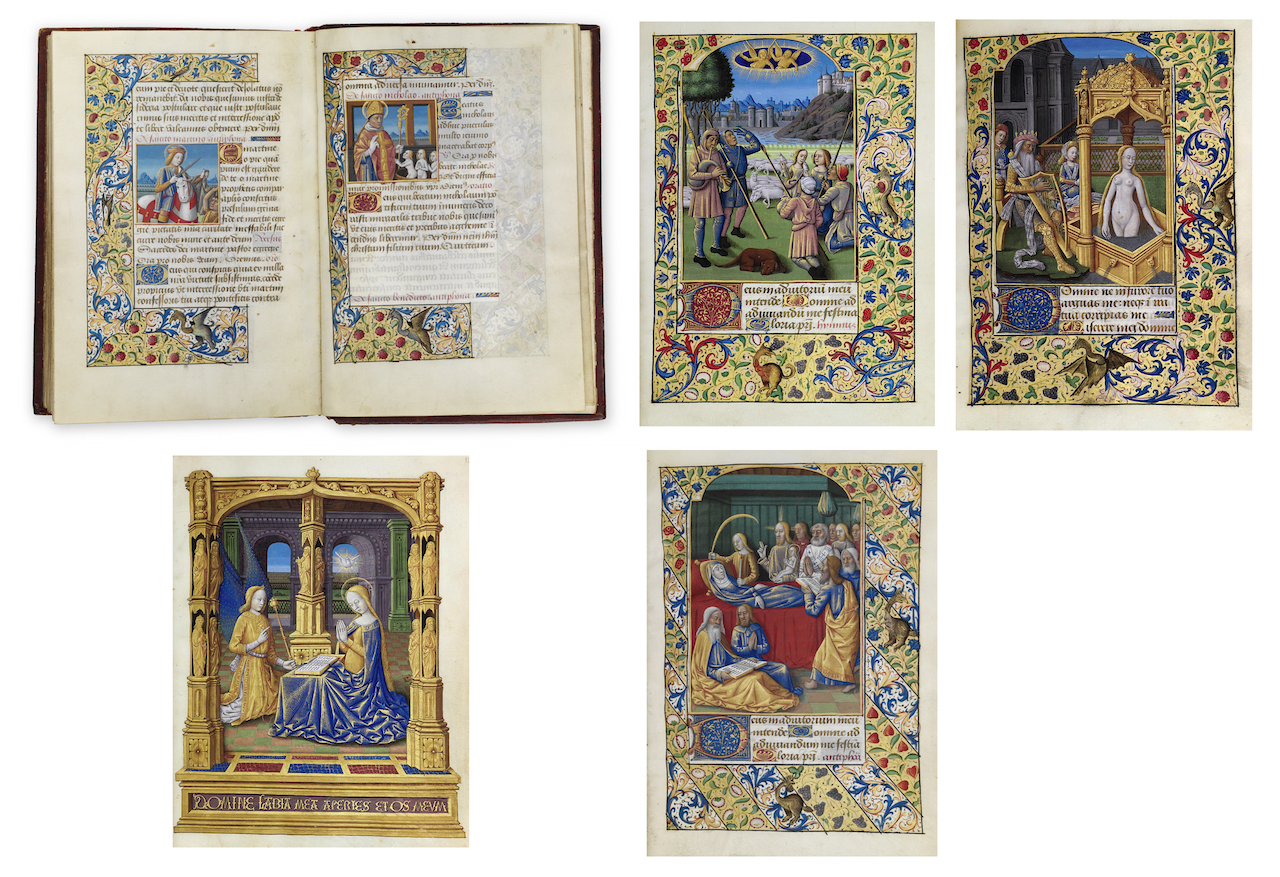
Londen, Christie’s Catalogus 7 juli 2010 (Arcana Collection: Exceptional Illuminated Manuscripts, Part I), lot 41 Katherina getijdenboek
THE KATHERINA HOURS, use of Rome, in Latin and French, ILLUMINATED MANUSCRIPT ON VELLUM
[Tours, c.1485-90]
Master of the Hours of Jean Charpentier
213 x 150mm. 96 leaves, lacking 6 leaves (including 3 with miniatures), TWENTY-ONE SMALL MINIATURES OR HISTORIATED INITIALS with three-sided illuminated borders, EIGHT LARGE MINIATURES in arched compartments within full-page borders, FULL-PAGE MINIATURE IN AN ARCHITECTURAL FRAME (inconsequential spots and small smudges in a few margins). English red morocco gilt, c.1700 (upper cover abraded, wear with loss at head and foot of spine). Late Victorian, c.1870-80, box of rosewood imitating a book with a binding à la cathédrale, inlaid on each side with a Gothic Revival design in ivory, sycamore and fruitwoods (lock defective).
PROVENANCE:
1. Made for a woman called Katherina who is named in prayers on ff.82 & 88v. St Catherine is also the first of the female saints in the Suffrages on ff.93-93v. The artist worked in Tours and most of the outdoor scenes appear to be located on the banks of the Loire.
2. A note in pencil, presumably written in 1824 calculates its date and age ‘executed in the reign of Henry the Seventh year 1485 – about 339 years old’.
3. E.U. Manning; given to Ruth M. Manning on 30 June 1937 (Manion and Vine, 1984).
4. Deposited on loan to the Fisher Library, University of Sydney 1981-7: their manuscript number ‘RB Add. Ms.59’ in pencil on the verso of the upper flyleaf.
CONTENT:
Calendar in Latin and French, ff.1-6v; Gospel Lessons, ff.7-10; ruled blanks, ff.11-12; Office of the Virgin, use of Rome, ff.13-43v: matins (lacking one leaf after f.13 and end) f.13, lauds (lacking opening) f.18, prime f.23v, terce f.26, sext f.29, none f.31v, vespers f.34, compline (lacking two leaves with opening) f.38; variants for the days of the week f.39, Hours of the Cross (lacking two leaves with all but last verse), f.44; Hours of the Holy Spirit, ff.44v-46v; Penitential Psalms. ff.47-53v, and Litany, ff.54-56v; Office of the Dead, use of Rome, ff.57-80v; ruled blank, f.81; Deus qui voluisti, ff.82-82v; Obsecro te (feminine forms), ff.82v-84v; ruled blanks, ff.85-86; Suffrages, ff. 87-95v: to Sts Michael f.87, Stephen f.87v, Sebastian f.87v, Christopher f.88v, Andrew f.89v, Claude f.89v, Martin f.90, Nicholas f.91, Benedict f.91v, ruled blanks ff.92-92v, Catherine f.93, Barbara f.93v, Margaret f.94, Geneviève f.94v, Apollonia f.95, Mary Magdalene f.95v, ruled blanks ff.96-96v.
ILLUMINATION:
This magnificent prayer-book is a particularly fine example of the mature illumination of the Master of the Hours of Jean Charpentier, a follower of Jean Fouquet active in Tours and neighbouring regions of the Loire Valley from 1475 to 1490. His eponymous manuscript (Angers, Bibl. municipale, Ms.2048) was commissioned by Jean Charpentier (d.1505), notary and secretary of King Charles VIII (1483-1498). The anonymous master’s artistic identity was first established by François Avril (‘Manuscrits à peintures d’origine français à la Bibliothèque nationale de Vienne’, Bulletin Monumental, vol.134, IV, 1976, pp.329-38). Evolutions in his style, however, led to his oeuvre being divided between two miniaturists named after Books of Hours in the Morgan Library: the Master of Morgan 96 and the Master of Morgan 366 (Plummer, 1982, pp.44-6). The stylistic similarity of the works indicates that they were produced in the same workshop and they are now generally assigned to a single artistic personality.
The harmonious palette of luminous gold and opaque blue, red, green and mauve, solid, poised figures with prominent round heads modelled by deep shadows, and their swathes of voluminous drapery highlighted in gold, as seen in the dress of the Virgin that envelopes the prie-dieu in the Annunciation, are characteristic of the Charpentier Master’s illuminations. His compositions and layouts show the influence of Jean Fouquet. For example, the positioning of the figures of Gabriel and the Virgin in an interior on either side of a window beyond which lies a garden fenced with trellises recalls Fouquet’s Annunciation in the Hours of Jean Robertet (New York, Morgan Library, Ms M.834, f.29). His painting style, however, is closer to the Master of Adelaide of Savoy (also known as the Master of Poitiers 30), who was active in Angers and Poitiers between c.1450 and 1470 (see Avril and Reynaud, 1993, pp.123-6, 288).
The subjects of the full-page and large miniatures are as follows: Annunciation f.13, Nativity f.23v, Annunciation to the Shepherds f.26, Adoration of the Magi f.29, Circumcision f.31v, Death of the Virgin f.34, Pentecost f.44v, David watching Bathsheba at her bath f.47, and Job on the dung heap f.57.
The subjects of the small miniatures and historiated initials are as follows: St John on Patmos with the eagle f.7, St Luke with the winged ox f.8, St Matthew with the angel f.8v, St Mark with the winged lion f.9v, Christ, wearing the crown of thorns and with wounded hands, blessing f.82, the Pietà f.82v, St Michael fighting the Devil f.87, St Stephen f.87v, St Sebastian f.87v, St Christopher f.88v, St Andrew f.89v, St. Claude f.89v, St Martin f.90v, St Nicholas and the three children f.91, St Benedict f.91v, St Catherine f.93, St Barbara f.93v, St Margaret f.94, St Geneviève f.94v, St Apollonia f.95, and the Penitent Mary Magdalene f.95v.
The Victorian faux-book box is a charming testament to the continuing value placed on the volume in the 19th century.
BIBLIOGRAPHY:
J. Plummer and G. Clark, The Last Flowering: French Painting in Manuscript, 1420-1530, 1982, pp. 44-6, this manuscript is mentioned as the Australian Horae on p. 45.
M. M. Manion and V. F. Vine, Medieval and Renaissance Illuminated Manuscripts in Australian Collections, 1984, no 81, pp. 202-3, pl. 44 in colour and figs. 229-34.
F. Avril and N. Reynaud, Les manuscrits à peintures en France 1440-1520, 1993, pp. 288-90, this manuscript is mentioned at its Sydney location on pp. 289-90.
C. Yvard, ‘Un livre dheures inédit du XVe siècle à la Chester Beatty Library de Dublin’, Art de lenluminure, 19 (Dec. 2006-Feb. 2007), p. [32] n. 36.